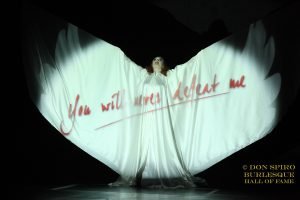 Most burlesque dancers throughout history would not have considered themselves “feminists”. In fact, many clashed with the feminists of the day who were attacking their livelihoods. But feminist principles are found throughout burlesque’s history. Women in burlesque defied social and gender norms to assert themselves and their bodies. As artists, as workers, and as women, burlesque performers practiced on stage the ideals that feminists put forth in their books, essays, and speeches.
Most burlesque dancers throughout history would not have considered themselves “feminists”. In fact, many clashed with the feminists of the day who were attacking their livelihoods. But feminist principles are found throughout burlesque’s history. Women in burlesque defied social and gender norms to assert themselves and their bodies. As artists, as workers, and as women, burlesque performers practiced on stage the ideals that feminists put forth in their books, essays, and speeches.
In the 19th century, when women were better appreciated as unseen, unheard helpmeets and homemakers, burlesque performers made women and women’s place very visible. They not only performed on stage, itself an affront to Victorian sensibilities, they owned their companies, traveled alone, and enjoyed a freedom few women of the time could imagine. Later stripteasers presented ideas about women’s bodies and sexualities that would not become mainstream until the late 20th century. Today, women in burlesque again create their own acts, produce their own shows, and speak their own minds – and use the stage to celebrate all bodies and sexualities, regardless of body shape, age, color, or physical ability.
The Burlesque Hall of Fame’s ongoing exhibition Dancing the Revolution: Feminism in Burlesque History explores the feminist ideals that flow through and from the burlesque stage. See it in the Bawdy Shop Studio starting May 31, 2019.

